To protect yourself when bottling oils, you'll need proper safety equipment like gloves, goggles, and aprons, along with spill containment tools and fire safety gear. Always use clean, food-grade transfer equipment and maintain strict temperature controls below 20℃ in dark storage areas. Prevent cross-contamination by using dedicated containers, following FDA regulations, and implementing proper disposal practices. These fundamentals are just the start of creating a secure oil bottling operation.
Essential Safety Equipment and Protective Gear
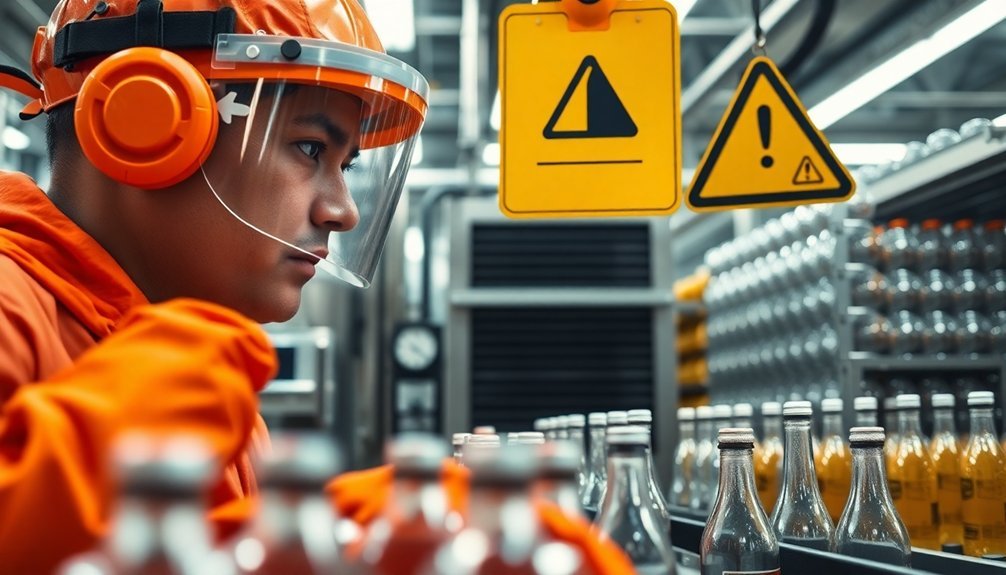
When working with oil bottling operations, proper safety equipment and protective gear serve as your first line of defense against workplace hazards.
You'll need to wear appropriate PPE, including gloves, goggles, and aprons to protect yourself from chemical exposure while handling essential oil products.
Keep spill containment equipment readily available, including absorbent pads and spill kits, so you can quickly address any accidental spills.
You'll also want to guarantee fire safety equipment like extinguishers and proper storage cabinets are within easy reach when working with flammable liquids.
Don't forget to familiarize yourself with the safety data sheets, which provide vital information about potential hazards and necessary precautions.
Regular training on using these safety tools and emergency protocols will help you maintain a secure bottling environment.
Proper Bottle Selection and Material Requirements
Three critical factors determine successful oil bottling: container type, material composition, and size selection.
When it comes to oil packaging, you'll need to choose between dropper bottles, roll-ons, or spray assemblies based on your application needs. Always opt for dark glass containers, particularly amber ones, as they shield your oils from harmful UV rays that can degrade their quality.
You'll want to avoid plastic containers since they can't properly protect against environmental factors and may lead to leakage.
For precise measurements, consider 5ml or 10ml bottles with reliable dispensing mechanisms. Don't overlook the importance of high-quality caps – they're essential for preventing evaporation and keeping contaminants out of your oils.
These choices directly impact the longevity and effectiveness of your essential oil products.
Sterilization Techniques for Oil Containers
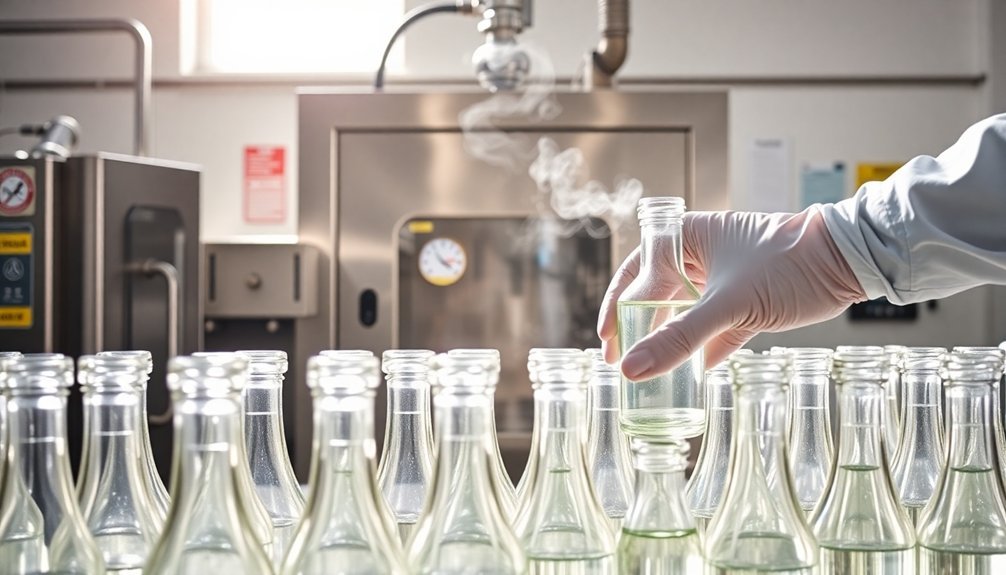
Before sterilizing your oil containers, you'll need to thoroughly clean them using food-grade sanitizers or a diluted bleach solution.
To heat-sterilize glass containers, place them in an oven at 320°F for 30 minutes, ensuring complete sanitization of all surfaces.
For plastic containers, opt for chemical sterilization with a 1:10 bleach solution, followed by thorough rinsing and complete air-drying in a clean environment.
Effective Cleaning Methods
Proper sterilization of oil containers stands as a critical step in guaranteeing the quality and safety of bottled oils. You'll need to choose the right cleaning method based on your container type and materials on hand.
| Container Type | Sterilization Method | Time Required |
|---|---|---|
| Glass Bottles | Oven Heat (320°F) | 30 minutes |
| Plastic Containers | Bleach Solution | 10 minutes |
| Essential Oil Bottles | Steam Treatment | 15-20 minutes |
Before storing your oils, you'll want to wash containers with hot, soapy water and rinse thoroughly. For glass containers, use dry heat in your oven at 160°C. If you're working with plastic, create a solution using 1 tablespoon of unscented bleach per gallon of water. Always guarantee containers are completely dry before filling them with oil to prevent moisture-induced rancidity.
Heat Treatment Guidelines
When sterilizing oil containers through heat treatment, you'll need to maintain temperatures of at least 160°F (71°C) for 30 minutes to eliminate harmful microorganisms. Following proper heat treatment guidelines is vital for different container materials.
Choose your sterilization method based on your container type:
- Use steam sterilization for glass containers to guarantee thorough surface penetration.
- Keep plastic containers below 200°F (93°C) to prevent warping.
- Preheat containers before filling to minimize thermal shock.
After completing the heat treatment process, you'll want to follow proper cooling procedures to prevent condensation inside your containers. This step is important because moisture from improper cooling can lead to contamination when you seal the containers.
Remember that consistent adherence to these heat treatment guidelines guarantees your oil remains safe for consumption.
Safe Handling and Transfer Procedures
You'll need to clean all transfer equipment thoroughly before moving oils between containers to prevent contamination and maintain product quality.
When pouring oils, make sure you're using proper spill containment methods and working over designated catch basins to contain any potential drips or overflow.
Don't forget to protect yourself by wearing appropriate safety gear, including chemical-resistant gloves and safety goggles, throughout the entire transfer process.
Clean Transfer Equipment First
The first critical step in safe oil bottling involves thoroughly cleaning and sterilizing all transfer equipment.
You'll need to use food-grade cleaning agents on your pipettes, funnels, and other transfer tools to prevent any harmful residues from affecting oil quality.
To maintain clean transfer equipment effectively, follow these essential practices:
- Inspect all equipment before each use for damage or wear
- Document your cleaning procedures to guarantee consistent standards
- Follow a regular maintenance schedule aligned with transfer frequency
Prevent Spills During Pouring
Implementing safe handling procedures during oil transfers prevents costly spills and product waste. You'll need to use funnels and spouts to maintain control while pouring, ensuring a steady flow into the target container. Place drip pans or absorbent mats beneath your work area to catch any accidental drips.
| Equipment | Purpose | Safety Benefit |
|---|---|---|
| Funnel/Spout | Flow Control | Prevents Splashing |
| Drip Pan | Spill Containment | Catches Leaks |
| Storage Berm | Proper Storage | Contains Major Spills |
Before starting any transfer, check that both containers are stable and positioned correctly. Inspect your equipment regularly for wear and damage that could compromise safety. Using containment berms in your storage areas provides an extra layer of protection against unexpected leaks, ensuring your workspace remains clean and compliant with safety standards.
Wear Protective Safety Gear
When handling oils during bottling operations, proper safety gear serves as your first line of defense against hazardous splashes and spills.
You'll need to wear protective safety gear that meets OSHA standards before starting any oil transfer procedures.
Essential protective equipment includes:
- Chemical-resistant gloves that fit properly
- Safety goggles with a secure seal around your eyes
- Chemical-resistant aprons to protect your clothing
Don't forget to inspect your safety equipment regularly for wear and tear.
You'll want to replace any damaged items immediately to maintain proper protection.
When transferring oils, always use appropriate equipment like pumps or funnels designed for your specific oil type.
Keep spill containment materials nearby, including absorbent pads and spill berms, to quickly address any accidents that might occur during the bottling process.
Storage Temperature and Light Control Standards
Proper storage conditions play a vital role in maintaining oil quality and extending shelf life. When bottling oil, it's important to establish strict temperature and light control standards to preserve its properties.
You'll need to maintain storage temperatures below 20℃ in a cool, dark pantry. Choose dark glass bottles to protect your oil from UV rays that can degrade antioxidants and alter flavors.
If you're bottling for retail, opt for smaller containers that minimize air exposure during customer use. This approach helps prevent oxidation and maintains freshness longer.
Remember that your unopened extra virgin oil can last up to 24 months when stored properly, but once opened, you should advise customers to use it within 1.5 months.
These standards guarantee your bottled oil maintains its quality from production to consumption.
Cross-Contamination Prevention Methods

Beyond temperature and light control, strict hygiene protocols form the backbone of quality oil bottling operations. By implementing effective cross-contamination prevention methods, you'll protect the integrity of each oil type and guarantee product safety. Use dedicated containers and tools for different oils, and always sanitize equipment before use.
To maintain strict quality control, you'll need to:
- Label all bottles clearly with contents and production dates
- Train your staff on proper handling techniques
- Use separate utensils for each oil type
Regular audits of your storage and production areas help verify compliance with these protocols.
Hazardous Material Classification Guidelines
You'll need to maintain detailed Material Safety Data Sheets (MSDS) for each oil type in your bottling facility, documenting their physical properties, hazard classifications, and handling requirements.
To properly classify your oils, you must conduct standardized flash point testing and evaluate other safety characteristics according to OSHA's HCS guidelines.
Your bottled oils that meet hazardous material criteria require appropriate DOT warning labels before transport, including clear hazard symbols and emergency response information.
Material Safety Data Requirements
Safety documentation plays an essential role in oil bottling operations, with Material Safety Data Sheets (MSDS) or Safety Data Sheets (SDS) serving as critical resources for handling hazardous materials.
You'll need to maintain these standardized documents to comply with OSHA's Hazard Communication Standard and protect your workforce.
Each SDS must include important information in a 16-section format:
- Chemical properties and composition details
- Health hazards and first-aid measures
- Safe handling procedures and emergency responses
You're required to guarantee all SDSs are accurate, up-to-date, and easily accessible to your employees.
Following the Globally Harmonized System (GHS) for classification and labeling is crucial, as it promotes consistent hazard communication across borders.
Classification Testing Standards
While maintaining accurate safety documentation forms the foundation of oil bottling compliance, proper classification testing stands as the next essential step in your operation's safety protocol.
You'll need to follow strict classification testing standards set by OSHA and EPA to identify potential hazards in your stored chemicals and oils.
Start by conducting flashpoint testing for all your liquids – if they're below 100°F, you must classify them as flammable; above that threshold, they're considered combustible.
You'll also need to align with GHS guidelines, which provide a standardized system for categorizing physical, health, and environmental hazards.
Don't forget to regularly review your Safety Data Sheets and conduct compliance audits to guarantee you're meeting TSCA requirements and maintaining current classifications for all materials in your facility.
Transport Warning Labels
Proper labeling of hazardous materials serves as your first line of defense in safe transportation practices.
When you're shipping oil products, you'll need to comply with DOT regulations by using transport warning labels that clearly display hazard symbols and classification numbers.
Your shipping containers must include:
- A proper shipping name that identifies the material
- The appropriate hazard class from DOT's nine classifications
- A UN identification number for emergency response
Don't overlook these labeling requirements, as they're essential for legal compliance with the Hazardous Materials Transportation Act.
You'll face substantial fines if your packages aren't properly labeled according to regulations.
Remember that these transport warning labels aren't just regulatory requirements—they're vital safety measures that protect handlers and emergency responders throughout the shipping process.
Ventilation and Workspace Safety Protocols
Maintaining a well-ventilated workspace is essential when bottling oils to prevent dangerous vapor buildup and protect workers' health.
You'll need to regularly check your ventilation systems and replace filters to guarantee proper air circulation throughout your facility.
Keep your workspace clean and organized to prevent accidents and guarantee quick access to emergency exits.
Don't let clutter accumulate, as it can create hazards and block important safety routes.
You'll also need to wear appropriate PPE, including gloves and masks, when handling oils to protect yourself from potential allergens and irritants.
Make sure you've established clear emergency procedures for handling spills and evacuations.
Post these protocols where everyone can see them, and guarantee all staff members know exactly what to do if an incident occurs.
Emergency Response and Spill Management
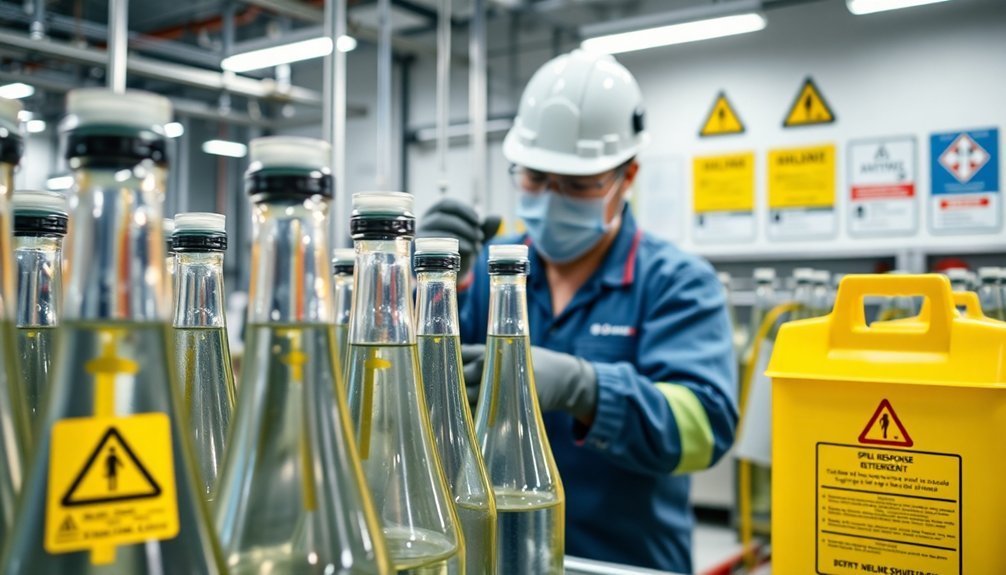
Since accidents can happen even with preventive measures in place, you'll need a thorough emergency response plan that meets OSHA and EPA requirements.
If your facility stores over 1,320 gallons of oil, you must develop a spill containment strategy and conduct regular inspections.
Your emergency response preparations should include:
- Secondary containment systems that hold at least 10% of primary container volume
- Properly labeled chemical storage areas with containment bins
- Quick-access spill kits and containment berms for immediate response
Train your employees thoroughly on emergency response procedures and maintain proper documentation of all training sessions.
Confirm your secondary containment systems can handle potential storm runoff, and keep spill management equipment readily accessible throughout your facility.
Regular maintenance checks and proper chemical storage practices will help minimize risks and maintain compliance with regulations.
Quality Control Testing Requirements
Quality control serves as the backbone of your oil bottling operation, requiring strict adherence to ISO standards and FDA regulations.
You'll need to implement thorough quality control testing that includes evaluating residue and water content according to ISO 4715 and ISO 11021 standards.
To guarantee your oils meet safety requirements, you must conduct gas chromatography tests to verify purity and identify potential contaminants.
The FDA requires safety testing to check for harmful substances and allergens, while TSCA compliance demands proper documentation of any hazardous chemicals present in your products.
Don't forget to regularly audit your labeling practices to comply with FPLA regulations.
These testing requirements protect both your business and consumers by maintaining product integrity and ensuring accurate information reaches your customers.
Labeling and Documentation Standards
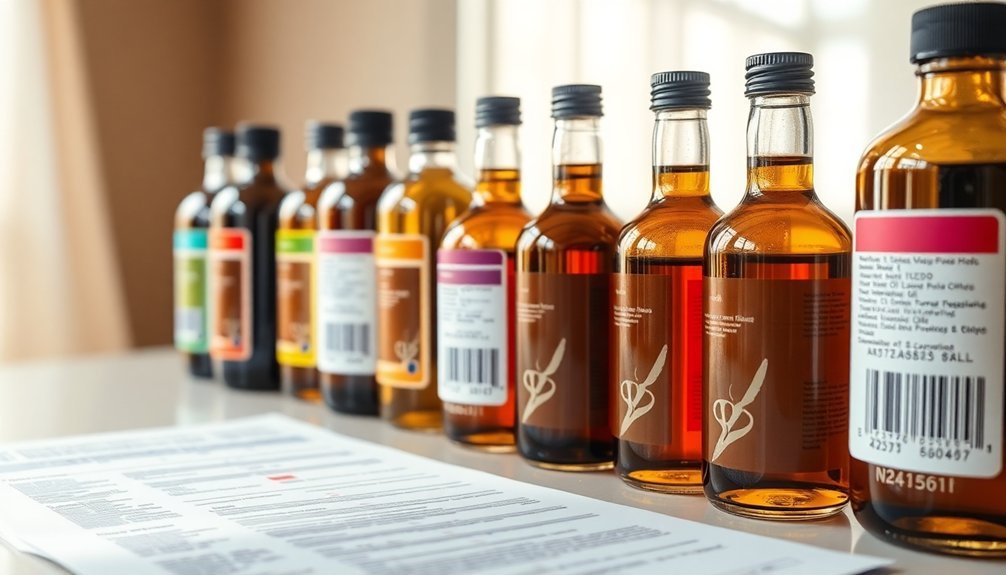
With your quality control measures in place, proper labeling becomes your next major compliance focus.
As an essential oils producer, you'll need to meet strict labeling and documentation standards to guarantee consumer safety and regulatory compliance.
Your labels must include:
- The product identity and net quantity in both imperial and metric units
- Your company's name and complete address
- Clear allergen warnings and intended use statements
Don't forget California's Proposition 65 requirements – you'll need specific warning labels if your essential oils contain substances exceeding allowable limits for cancer or reproductive harm.
Stay current by regularly checking your ingredients against the Proposition 65 List.
You're also responsible for making sure your cosmetic essential oil labels comply with FDA regulations under 21 CFR, preventing any misbranding issues that could impact your business.
Safe Disposal and Recycling Practices
Properly managing used oil disposal and recycling isn't just an environmental responsibility – it's a legal requirement for your bottling operation.
You'll need to guarantee all used oil is transported to designated recycling centers or collected through your municipality's approved programs.
Before transport, secure your oil in tightly sealed containers to prevent any leaks or spills.
Check your local guidelines, as some areas offer curbside pickup while others require facility drop-offs.
Never dispose of used oil in regular trash or pour it down drains – these actions are illegal and can result in hefty fines.
Remember that proper recycling creates opportunities for resource recovery.
Your used oil can be reprocessed into new lubricants or converted into fuel, making safe disposal not just compliant but also environmentally beneficial.
Frequently Asked Questions
What Are Oil Storage Regulations?
You'll need to follow EPA's SPCC rules if you store over 1,320 gallons of oil. You must maintain proper containment systems, implement spill prevention plans, and guarantee your storage areas meet safety requirements.
Do I Need a License to Sell Oils?
You'll typically need a business license and seller's permit to sell oils legally. Check your local regulations, as some states require additional certifications. Don't forget liability insurance and FDA compliance for therapeutic claims.
Should Olive Oil Be Stored in Glass or Plastic?
You'll want to store olive oil in dark glass bottles, not plastic. Glass protects against UV rays, prevents chemical leaching, and helps maintain the oil's quality and antioxidant benefits for a longer shelf life.
Are Essential Oils Regulated by the FDA?
Yes, the FDA regulates essential oils, but the oversight depends on how you're using them. They're regulated as cosmetics, food additives, or drugs based on your intended use and product claims.
In Summary
Follow these oil bottling rules diligently – they're your defense against contamination, spills, and safety hazards. You'll protect yourself and others by using proper safety gear, maintaining sterile conditions, and handling oils correctly. Don't skip quality testing or proper labeling steps. Remember, when you've got the right storage, emergency protocols, and disposal practices in place, you're setting yourself up for safe, compliant operations.
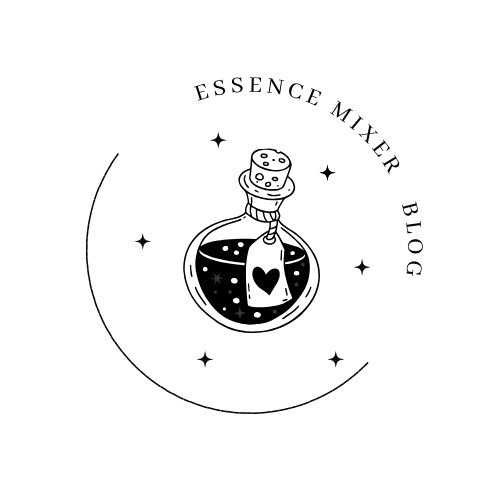
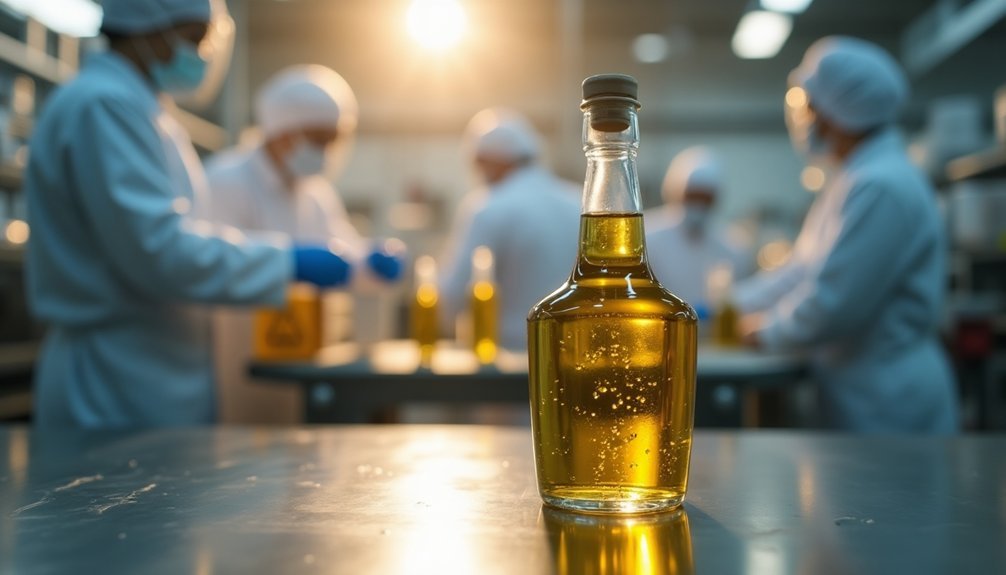



Leave a Reply